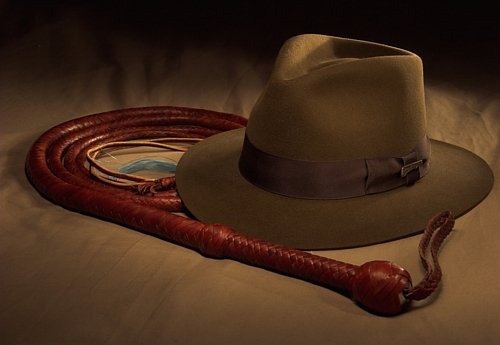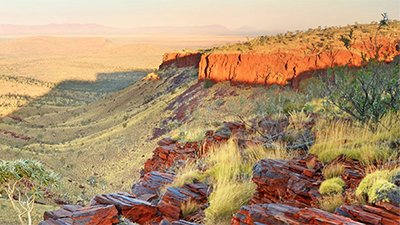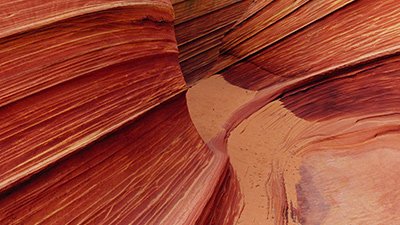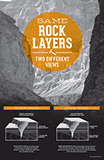“They Are Digging in the Wrong Place!”
In the movie Indiana Jones and the Raiders of the Lost Ark, there was a medallion that ultimately gave calculated directions to the precise location where the Ark of the Covenant was hidden—a lost, buried city. On both sides, the medallion was engraved with calculations for making a staff on which to attach the medallion.

Image by Gary2880, via Wikimedia Commons.
Indiana Jones had the medallion, but the “bad guys,” led by a man named Belloq, had an imprint of just one side of the medallion. The bad guys didn’t know that the rest of the calculation was on the opposite side of the medallion. Upon realizing this, Indiana Jones says, “Belloq’s staff is too long. They are digging in the wrong place!”1
So why is this significant?
Evolutionary Diggings . . . in the Wrong Place Too?
Each year there are many headlines, books, technical articles, and videos about another supposed missing link—a supposed link between a land mammal and whale, a dinosaur and bird, an ape and human, and so forth. Usually, these are quite easy to refute by anatomical features.
For example, alleged missing links turn out to be anything but—for example, either ape, human, or a fake (e.g., Piltdown man) or dinosaur, bird, or a fake (e.g., Archaeoraptor).
Nevertheless, these alleged missing links rarely make creationists cringe. I think it frustrates some of the evolutionists because they think they have found some sort of knock-out evidence that they interpret as support for evolution. But creationists rarely bat an eye.
Well, I’m going to let you in on a secret as to why creationists rarely take notice of these alleged missing links. It is because the evolutionists are digging in the wrong place—just like the bad guys in Indiana Jones. When you don’t have the correct information, you can miss the mark significantly.
What Do You Mean by “Digging in the Wrong Place”?
Essentially, here are the geologic rock layers (strata):
| Rock layer | |
|---|---|
| 1 | Recent |
| 2 | Pleistocene |
| 3 | Pliocene |
| 4 | Miocene |
| 5 | Oligocene |
| 6 | Eocene |
| 7 | Paleocene |
| 8 | Cretaceous |
| 9 | Jurassic |
| 10 | Triassic |
| 11 | Permian |
| 12 | Pennsylvanian |
| 13 | Mississippian |
| 14 | Devonian |
| 15 | Silurian |
| 16 | Ordovician |
| 17 | Cambrian |
| 18 | Precambrian |
Typically, evolutionists are searching for alleged human missing links in the upper strata like Pleistocene and Pliocene (bolded).
| Rock layer | |
|---|---|
| 1 | Recent |
| 2 | Pleistocene |
| 3 | Pliocene |
| 4 | Miocene |
| 5 | Oligocene |
| 6 | Eocene |
| 7 | Paleocene |
| 8 | Cretaceous |
| 9 | Jurassic |
| 10 | Triassic |
| 11 | Permian |
| 12 | Pennsylvanian |
| 13 | Mississippian |
| 14 | Devonian |
| 15 | Silurian |
| 16 | Ordovician |
| 17 | Cambrian |
| 18 | Precambrian |
In a general sense, evolutionists look for alleged dinosaur-to-bird missing links in the Cretaceous and Paleocene (bolded).
| Rock layer | |
|---|---|
| 1 | Recent |
| 2 | Pleistocene |
| 3 | Pliocene |
| 4 | Miocene |
| 5 | Oligocene |
| 6 | Eocene |
| 7 | Paleocene |
| 8 | Cretaceous |
| 9 | Jurassic |
| 10 | Triassic |
| 11 | Permian |
| 12 | Pennsylvanian |
| 13 | Mississippian |
| 14 | Devonian |
| 15 | Silurian |
| 16 | Ordovician |
| 17 | Cambrian |
| 18 | Precambrian |
But here is the problem. The rock layers from Cambrian to Miocene—at least mapped in the mountains of Ararat (Genesis 8:4)—were from the Flood.2 Miocene and Eocene rock is intricately part of the makeup of the mountains of Ararat, as is Cretaceous and Triassic (many times inverted, lying above the Miocene and Eocene). Since that time, the upper strata are post-Flood strata—such as Ice Age layers and recent volcanic flows. I understand creationists debate about tertiary sediment (Paleocene through Miocene) and encourage you study this further.3
| Rock layer | Timeline | |
|---|---|---|
| 1 | Recent | Post-Flood |
| 2 | Pleistocene | Post-Flood |
| 3 | Pliocene | Post-Flood |
| 4 | Miocene | Flood |
| 5 | Oligocene | Flood |
| 6 | Eocene | Flood |
| 7 | Paleocene | Flood |
| 8 | Cretaceous | Flood |
| 9 | Jurassic | Flood |
| 10 | Triassic | Flood |
| 11 | Permian | Flood |
| 12 | Pennsylvanian | Flood |
| 13 | Mississippian | Flood |
| 14 | Devonian | Flood |
| 15 | Silurian | Flood |
| 16 | Ordovician | Flood |
| 17 | Cambrian | Flood |
| 18 | Precambrian | Pre-Flood |
So when evolutionists say they found a transitional form between an ape and a human in Pliocene rock, creationists hardly flinch. Evolutionists are looking at the rock strata and the age of the earth incorrectly because humans were around long before that rock was ever laid down! Furthermore, humans existed when the Cambrian rock was laid down during the Flood. To go one more step, mankind had dominated the earth for over 1,600 years before the Cambrian rock was laid down!
When someone says that they found a transitional form between a dinosaur and a bird in the Paleocene, again, creationists hardly think twice. Both specimens died the same year in the same Flood and are not related. This is why finding feathers in the rock layers “before the dinosaurs” is not a problem for creationists.4 Nor is it a problem when we find theropod dinosaurs (which supposedly evolved into birds in the evolutionary story) that had eaten birds in lower Cretaceous rock.5
Birds were made on Day Five, which is a day before the dinosaurs; land animals, like dinosaurs, were made on Day Six. Having both buried in Flood sediment isn’t a big deal.
Indeed Digging in the Wrong Place . . .
If evolutionists want to get creationists to take notice, then they need to find all these alleged transitional forms in the pre-Cambrian (essentially pre-Flood) rocks. But keep in mind that we had over 1,600 years of erosion and rock strata where people and animals did coexist before the Flood.
Consider the evolutionists for a moment. Would they be convinced if a researcher found a body of a person preserved from the Mount St. Helens eruption and claimed it was the earliest human ancestor? Not at all, because that sediment came from a catastrophe that happened well after people were around. It is the same with the Flood and post-Flood sediment. It was formed after people, birds, whales, and all other creatures were around.
The point is that evolutionists keep digging in the wrong place, yet they wonder why we hardly take notice. Well . . . this is why.
So Why Don’t Evolutionists Look at Flood Rock and Recognize It as “Flood Rock”?
Biblical creationists presuppose the Bible’s truth and subsequently the true history of the earth—including Noah’s Flood. Evolutionists have presuppositions too, albeit, false ones, but presuppositions nonetheless. This is why when evolutionists look at Flood rock they unwittingly believe that the rock was actually laid down slowly and gradually over long ages. I suggest they have been indoctrinated to believe such stories as gradual rock accumulation over millions of years which has never been observed or repeated. Thus, the concept of millions of years is not in the realm of science but interpretation.
Nevertheless, God and his Word are the ultimate standard, and any standard—man’s opinion—that opposes God and his Word is a lesser standard—a false authority fallacy. But the battle is about worldview. The evolutionists have a false worldview about rock layers from the Flood. It is this false worldview that drives their conclusions in hopes of finding missing links.
A correct worldview can help researchers get back on the right track and have a correct understanding of Flood rock and evidences. Let God be true and every man be found a liar (Romans 3:4).
Footnotes
- “They’re Digging in the Wrong Place,” Indiana Jones and the Raiders of the Lost Ark, directed by Steven Spielberg (Los Angeles, CA: Pictures, 1981).
- I’m denoting these bolded layers as Flood because Miocene, Eocene, Cretaceous, and Triassic sediments are found in the makeup of the Mountains of Ararat (formed by the 150th day of the Flood), so these specific layers were indeed Flood layers. Even if other Miocene-Paleocene were post-Flood layers, the article’s same point is made. Though there is debate on tertiary sediment elsewhere in the world being Flood or post-Flood, it is not for this article (see footnote 4). Y. Yilmaz, “Alochthonous Terranes in the Tethyan Middle East: Anatolia and the Surrounding Regions,” Philosophical Transactions of the Royal Society A 331 (1990): 611–624; G. C. Schmidt, “A Review of Permian and Mesozoic Formations Exposed Near the Turkey/Iraq Border at Harbol,” Bulletin of the Mineral Research and Exploration Institute 62 (1964): 103–119.
- The debate over the Flood/Post-Flood boundary is an ongoing debate in creationist literature. I suggest starting with the discussion here: Andrew Snelling. Earth’s Catastrophic Past. Green Forest, AR: Master Books, 2010, https://answersingenesis.org/store/sku/10-3-124/.
- Jeff Hecht, “Reptile Grew Feather-Like Structures Before Dinosaurs,” New Scientist 2857 (2012), 8; When these feathers were found, the researchers arbitrarily and without warrant said they attach to a pre-dinosaur reptile (in the evolutionary view). However, the feathers would have attached to this reptile in an anatomically impossible way. This proves the feathers were not part of the reptile.
- Lida Xing, et al., “Abdominal Contents from Two Large Early Cretaceous Compsognathids (Dinosauria: Theropoda) Demonstrate Feeding on Confuciusornithids and Dromaeosaurids,” PLOS, August 29, 2012, doi:10.1371/journal.pone.0044012.
Recommended Resources

Answers in Genesis is an apologetics ministry, dedicated to helping Christians defend their faith and proclaim the good news of Jesus Christ.
- Customer Service 800.778.3390
- © 2024 Answers in Genesis






